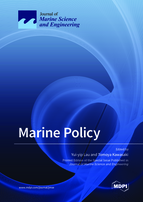Marine Policy
A special issue of Journal of Marine Science and Engineering (ISSN 2077-1312). This special issue belongs to the section "Marine Environmental Science".
Deadline for manuscript submissions: closed (5 September 2022) | Viewed by 48228
Special Issue Editors
Interests: cruise ships; ferries; impacts of climate change; shipping education and training; transport history; sustainability issues; resilient supply chain management; health logistics; human remains and regional development
Special Issues, Collections and Topics in MDPI journals
Interests: supply chain management (SCM); value chain management (VCM); logistics systems optimization; graph analysis; big data analysis
Special Issues, Collections and Topics in MDPI journals
Special Issue Information
Dear Colleagues,
Maritime transport contributes over 80% of global trading volumes. As such, marine policy has received a large amount of attention from industrial practitioners, researchers, policymakers, and the local community. In general, marine policy covers a wide-ranging area, including governance, international relations, economics, environmental, and operations, to name but a few. To a certain extent, marine policy fosters the sustainable development of the maritime industry. There has been a wide range of research in different disciplines of marine policy.
The purpose of the invited Special Issue is to publish the most exciting research with respect to the above subjects and to provide a rapid turn-around time regarding reviewing and publishing, and to disseminate articles freely for research, teaching, and reference purposes. Further, the Special Issue aims to keep readers up to date with the latest developments and research in maritime affairs.
High-quality papers are encouraged, for publication, directly related to various aspects, as mentioned below.
Dr. Yui-yip Lau
Dr. Tomoya Kawasaki
Guest Editors
Manuscript Submission Information
Manuscripts should be submitted online at www.mdpi.com by registering and logging in to this website. Once you are registered, click here to go to the submission form. Manuscripts can be submitted until the deadline. All submissions that pass pre-check are peer-reviewed. Accepted papers will be published continuously in the journal (as soon as accepted) and will be listed together on the special issue website. Research articles, review articles as well as short communications are invited. For planned papers, a title and short abstract (about 100 words) can be sent to the Editorial Office for announcement on this website.
Submitted manuscripts should not have been published previously, nor be under consideration for publication elsewhere (except conference proceedings papers). All manuscripts are thoroughly refereed through a single-blind peer-review process. A guide for authors and other relevant information for submission of manuscripts is available on the Instructions for Authors page. Journal of Marine Science and Engineering is an international peer-reviewed open access monthly journal published by MDPI.
Please visit the Instructions for Authors page before submitting a manuscript. The Article Processing Charge (APC) for publication in this open access journal is 2600 CHF (Swiss Francs). Submitted papers should be well formatted and use good English. Authors may use MDPI's English editing service prior to publication or during author revisions.
Keywords
- safety and accident
- coastal management and shipping
- marine pollution and environment
- waste management of marine resources
- disaster and natural hazards
- adaptation and resilience of maritime logistics in the post-pandemic world
- cruise
- ferry
- port governance







